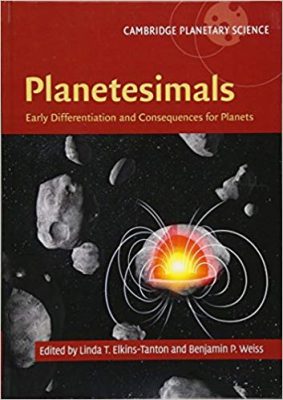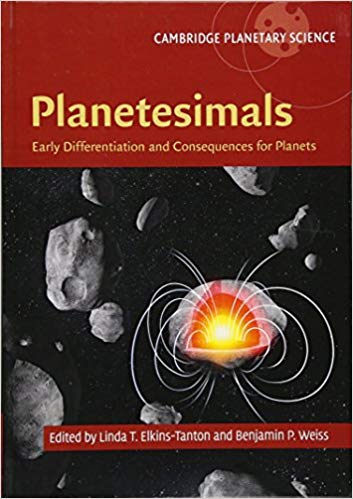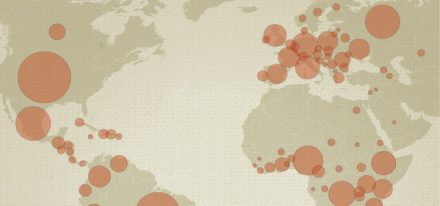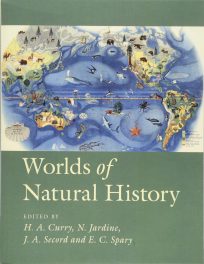 Editors: Linda T. Elkins-Tanton, and Benjamin P. Weiss
Editors: Linda T. Elkins-Tanton, and Benjamin P. Weiss
Publisher: Cambridge University Press – 381 pages
Book Review by: Sonu Chandiram
A basic understanding of the evolution of planets and relatively smaller planets termed plenetisimials involves an analysis (the how and the why) of the following stages of that evolutionary process:
- How rocky planets are formed
- How water is delivered to them
- How atmospheres surround and envelop the planets
- How cores and magnetic dynamos develop
- Why and which planets become habitable for living organisms
These basic phenomena are the topics of analysis and discussion of this unusual and intriguing book. You probably have never before come across the term ‘planetisimals’ and neither had I. What came to my mind was the word ‘infinitesimal’ which means extremely small. Since the size of an object is relative to other similar objects, I was curious to learn what some of the known planetisimals are, and their relative sizes to the planets in our own solar system, from the smallest which is Mercury, to the largest one that is Jupiter?
A reading of this book will give you the answers, and I assure you that you will be shocked how tiny some planetisimals really are. Note that in our 10-member solar system of planets surrounding the Sun, the four small ones are essentially made of rock and metal. In relative size they are: Mercury, Venus, Earth and Mars. The other four outer planets are the giants: Saturn and Jupiter (formed essentially of the gases hydrogen and helium) and the outermost are Uranus and Neptune (formed essentially of ice). The two planets Pluto and Eris are described by astronomers as ‘trans-Neptunian objects.’.
The work of a lot of people in North America and Europe who work in varied but related fields led by its two editors, went into the development of this unique work that opens up a new vista of knowledge – planetisimals. .
Thirty-eight specialists in atmospheric, Earth, environmental, mineral, planetary, and space sciences; applied physics, astronomy, astrophysics, geology, geophysics, jet propulsion technology, and physics, from all over the United States and Hawaii and six other countries – Canada, Denmark, France, Germany, Switzerland, the United Kingdom – authored the 17 chapters of this book.
We list titles of the chapters below to provide you the extent of coverage and topics in this book:
- Planetisimals
- Part I. Dynamical Evolution
- Signatures of Hit-and-run Collisions
- Using the Main Asteroid Belt to Constrain Planetisimal and Planet Formation
- Part II. Chemical and Mineralogical Diversity
- Differentiation Under Highly Reducing Conditions: New Insights from Enstatites and Mercury
- Origin and Evolution of Volatile-rich Asteroids
- Silicate Melting and Volatile Loss During Differentiation in Planetisimals
- Iron and Stony-iron Meteorites: Evidence for the Formation, Crystallization, and Early-Impact Histories of Differentiated Planetisimals
- Arguments for the Non-existence of Magna Oceans in Asteroids
- Magnetic Fields in Asteroids and Planetisimals
- Magnetic Mineralogy and Meteorite Metal: PaleoEvidence for Dynamo Activity on Differentiated Planetisimals
- Chronology of Planetisimal Differentiation
- Stable Isotope Evidence for the Differentiation and Evolution of Planetisimals
- Part III. Asteroids as Records of Formation and Differentiation
- Composition of Solar System Small Bodies
- Evidence for Differentiation Among Asteroid Families
- Dawn at Vesta: Paradigms and Paradoxes
- Planetisimals in Debris Disks
- Part IV. Early Differentiation and Consequences for Planet Formation
- The Taxonomy of Planetisimals: Consequences for Planets
Perhaps the best and most succinct description of this uniquely fascinating work first published in 2017 (there may be more editions as new knowledge emerges) is provided by the editors themselves:
“This interdisciplinary volume presents an authoritative overview of the latest in our understanding of the processes of planet formation. Combining meteorite, asteroid, and icy body observations with theory and modeling of accretion and orbital dynamics, this text also provides insights into the exoplanetary system and the search for habitable worlds. This is an essential reference for those interested in planetary formation, solar system dynamics, exoplanets, and planetary habitability.”
This is a pioneering work opening up a new frontier in our knowledge of astronomy, and I highly recommend it to anyone who wants to expand their knowledge and understanding of our universe!
Editors:
Linda T. Elkins-Tanton is Director of the School of Earth and Space Exploration at the Arizona State University. Her research focuses on the evolution of terrestrial planets and their relationship between Earth and life on Earth. Linda Elkins-Tanton is a two-time National Academy of Sciences Kavli Frontiers of Science Fellow, and in 2012,was honored with an asteroid named (8252) Elkins-Tanton.
Benjamin P. Weiss is a Professor of Planetary Sciences at Massachusetts Institute of Technology and Chair of the Program in Planetary Sciences within the Department of Earth, Atmospheric, and Planetary Sciences. Weiss’ research interests include the formation, evolution and history of terrestrial planets and small bodies, He was awarded the Macelware Medal in 2009, and in 2012, he was honored with an asteroid name (8069) Benweiss.






